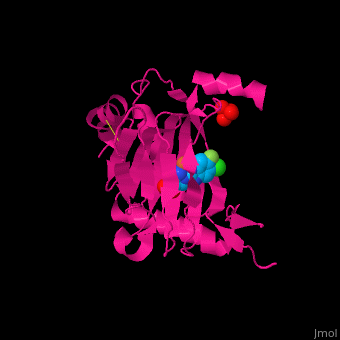Prolyl hydroxylase domain
From Proteopedia
| Line 2: | Line 2: | ||
'''Prolyl hydroxylase domain''' (PHD) proteins mediate oxygen-dependent degradation of Hypoxia-inducible factor (HIF) α subunit. They include PHD1, PHD2 and PHD3. The PHD is a Fe+2/oxogluterate (2OG)-dependent enzyme. [[3ouh]] is the crystallized structure of the enzyme PHD2, an [[oxidoreductase]] that is 237 amino acids long with a molecular weight of 27 kDa. [[3ouh]] is found in [http://en.wikipedia.org/wiki/Homo_sapiens Homo sapiens] and is a homolog of [http://en.wikipedia.org/wiki/EGLN1 EGLN1] found in [http://en.wikipedia.org/wiki/Caenorhabditis_elegans C. elegans]. | '''Prolyl hydroxylase domain''' (PHD) proteins mediate oxygen-dependent degradation of Hypoxia-inducible factor (HIF) α subunit. They include PHD1, PHD2 and PHD3. The PHD is a Fe+2/oxogluterate (2OG)-dependent enzyme. [[3ouh]] is the crystallized structure of the enzyme PHD2, an [[oxidoreductase]] that is 237 amino acids long with a molecular weight of 27 kDa. [[3ouh]] is found in [http://en.wikipedia.org/wiki/Homo_sapiens Homo sapiens] and is a homolog of [http://en.wikipedia.org/wiki/EGLN1 EGLN1] found in [http://en.wikipedia.org/wiki/Caenorhabditis_elegans C. elegans]. | ||
| - | The protein has three ligands: <scene name='45/459221/Cv/ | + | The protein has three ligands: <scene name='45/459221/Cv/4'>O14</scene> (a 1-(5-chloro-6-fluoro-1H-benzimidazol-2-yl)-1H-pyrazole-4-carboxylic acid), <scene name='45/459221/Cv/3'>Fe+2 (an iron ion)</scene>, and SO<sub>4</sub> (a sulfate ion). Water molecules are shown as red spheres. It is involved in mediating physiological responses to [http://en.wikipedia.org/wiki/Hypoxia_(medical) hypoxia] by degrading the transcription factor of a hypoxia-inducible factor HIF1-α. In hypoxic conditions, the activity of PHD2 lessens, causing an increase in HIF1-α, resulting in secretion of erythropoietin, anaerobic [[glycolysis]], and angiogenesis<ref>PMID:16686427</ref>. |
<ref>Rosen M D, Venkatesan H, Peltier H M, Bembenek S D, Kanelakis K C, Zhao L X, Leonard B E, Hocutt F M, Wu X, Palomino H L, Brondtetter T I, Haugh P V, Cagnon L, Yan W, Liotta L A, Young A, Mirzadegan T, Shankley N P, Barrett T D, Rabinowitz M H. Benzimidazole-2-pyrazole HIF Prolyl 4-Hydroxylase Inhibitors as Oral Erythropoietin Secretagogues. ACS Medicinal Chemical Letters. 2010 Oct 5.</ref> For more detalis see [[Molecular Playground/Prolyl Hydroxylase Domain (PHD) Enzyme]]. | <ref>Rosen M D, Venkatesan H, Peltier H M, Bembenek S D, Kanelakis K C, Zhao L X, Leonard B E, Hocutt F M, Wu X, Palomino H L, Brondtetter T I, Haugh P V, Cagnon L, Yan W, Liotta L A, Young A, Mirzadegan T, Shankley N P, Barrett T D, Rabinowitz M H. Benzimidazole-2-pyrazole HIF Prolyl 4-Hydroxylase Inhibitors as Oral Erythropoietin Secretagogues. ACS Medicinal Chemical Letters. 2010 Oct 5.</ref> For more detalis see [[Molecular Playground/Prolyl Hydroxylase Domain (PHD) Enzyme]]. | ||
Revision as of 13:12, 15 August 2019
| |||||||||||
3D Structures of prolyl hydroxylase domain
2y33 – hPHD2 + Zn + quinolin derivative – human
3ouh, 3oui, 5v18 - hPHD2 + Fe + inhibitor
4kbz - hPHD2 (mutant) + Fe + inhibitor
5a3u - hPHD2 + Mn + inhibitor
4jzr - hPHD2 + Ni + inhibitor
3ouj - hPHD2 + Fe + 2OG
5l9r - hPHD2 (mutant) + Mn + 2OG
3hqr, 5l9b - hPHD2 (mutant) + Mn + HIF 1 α C terminal + 2OG
5l9v, 5la9, 5las - hPHD2 (mutant) + Mn + HIF NODD domain + 2OG
3hqu - hPHD2 + Fe + HIF 1 α C terminal + quinolin derivative
2hbt, 2hbu, 2g19, 2g1m, [[2y34], 4bqi], 2y34 - hPHD2 + Fe + quinolin derivative
4bqw, 4bqx, 4bqy - hPHD2 + Mn + quinolin derivative
5lat, 5lb6, 5lbb, 5lbc, 5lbe, 5lbf, 4uwd - hPHD2 (mutant) + Mn + quinolin derivative
4h6j – hPHD Pasb domain (mutant) + aryl hydrocarbon nuclear translocator (mutant)
5v1b - hPHD1 + Fe + inhibitor
References
- ↑ Stolze IP, Mole DR, Ratcliffe PJ. Regulation of HIF: prolyl hydroxylases. Novartis Found Symp. 2006;272:15-25; discussion 25-36. PMID:16686427
- ↑ Rosen M D, Venkatesan H, Peltier H M, Bembenek S D, Kanelakis K C, Zhao L X, Leonard B E, Hocutt F M, Wu X, Palomino H L, Brondtetter T I, Haugh P V, Cagnon L, Yan W, Liotta L A, Young A, Mirzadegan T, Shankley N P, Barrett T D, Rabinowitz M H. Benzimidazole-2-pyrazole HIF Prolyl 4-Hydroxylase Inhibitors as Oral Erythropoietin Secretagogues. ACS Medicinal Chemical Letters. 2010 Oct 5.
Created with the participation of Andrew Winslow.

